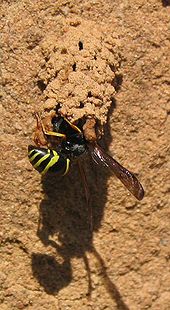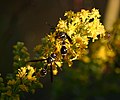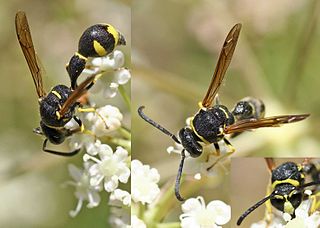
Eumenes is a genus of wasps in the subfamily Eumeninae. It is a large and widespread genus, with over 100 species and subspecies occurring worldwide. The genus was first proposed by Pierre André Latreille in 1802, with the type species later designated by Latreille in 1810. All species make jug-like nests out of mud, usually attached to twigs. The larvae are fed with caterpillars.
Brachymenes is a small neotropical genus of potter wasps currently containing two species, the primarily Andean species B. wagnerianus and the lowland species B. dyscherus.
Minixi is a small neotropical genus of potter wasps currently containing 4 species. One species is restricted to Southern United States, Mexico and Central America. The other three species are rather common and widespread through eastern South America.
Pirhosigma is a moderately small Neotropical genus of potter wasps.
Sphaeromenes is a small Neotropical genus of potter wasps.

Synagris is an Afrotropical genus of large potter wasps. Several Synagris wasps are strongly sexually dimorphic and males bear notable morphological secondary sexual traits including metasomal lamellar or angular protruding structures and hornlike or tusklike mandibular and/or clypeal projections.

Delta is an Old World genus of potter wasps with species predominantly distributed through tropical Africa and Asia. Some species are present in the Palearctic region, and a few have been introduced in the Nearctic and Neotropical regions. The members of this genus have a long metasomal petiole, like members of the genera Eumenes and Zeta.

Katamenes is a genus of potter wasps with species distributed in Europe and Africa. When originally named by Edmund Meade-Waldo, Katemenes was monotypic, containing only K. watsoni, but other species have since been moved from Eumenes to Katamenes.
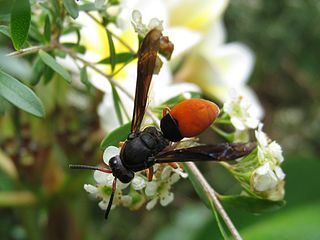
Pseudabispa is an Australian and Papuan genus of potter wasps containing 5 species, one of them subdivided in 4 subspecies.
Knemodynerus is a genus of potter wasps distributed through the Palearctic, Afrotropical, Indomalayan and Australasian regions. The species currently classified in the genus are:
Orientalicesa is a small Indomalayan genus of potter wasps.
Labus is an Indomalayan genus of potter wasps. It contains the following species:

Phimenes is an Indomalayan and Australasian genus of potter wasps. The genus was formerly regarded as a synonym of Delta. The genus was separated from Eumenes by the Italian hymenopterist Antonio Giordani Soika when he elevated division IV of Eumenes, which Saussure had given the name Phi to, to full generic status. However, Giordani Soika noted that the name Phi was preoccupied by a subgenus of the New World polistine genus Mischocyttarus and he therefore chose to compound Phi with Eumenes into Phimenes as the name for the new taxon.

Delta emarginatum is a species of potter wasp in the subfamily Eumeninae of the family Vespidae.

Katamenes arbustorum is a species of potter wasp in the subfamily Eumeninae of the family Vespidae.
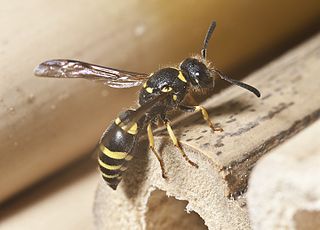
Ancistrocerus nigricornis is a species of potter wasp.
Antonio Giordani Soika was an Italian entomologist, ecologist and director of the Civic Museum of Natural History of Venice. He had a long career in which he worked on various groups of insects but much of his work was on the Hymenoptera. He made great contributions to the knowledge of Neotropical wasps, especially potter wasps for which he produced many taxonomic keys and also monographs on the systematics of the wasp family Vespidae.

Phimenes flavopictus is a species of potter wasp found in India, Sri Lanka, Nepal, China, Myanmar, Thailand, Malaysia, Singapore, and Indonesia.

Ancistrocerus longispinosus is a species of potter wasp, belonging to the family Vespidae, subfamily Eumeninae.

Symmorphus cristatus is a species of mason wasp in the subfamily Eumeninae within the family Vespidae. This species is widely distributed in North America, and it preys on the larvae of leaf beetles.



